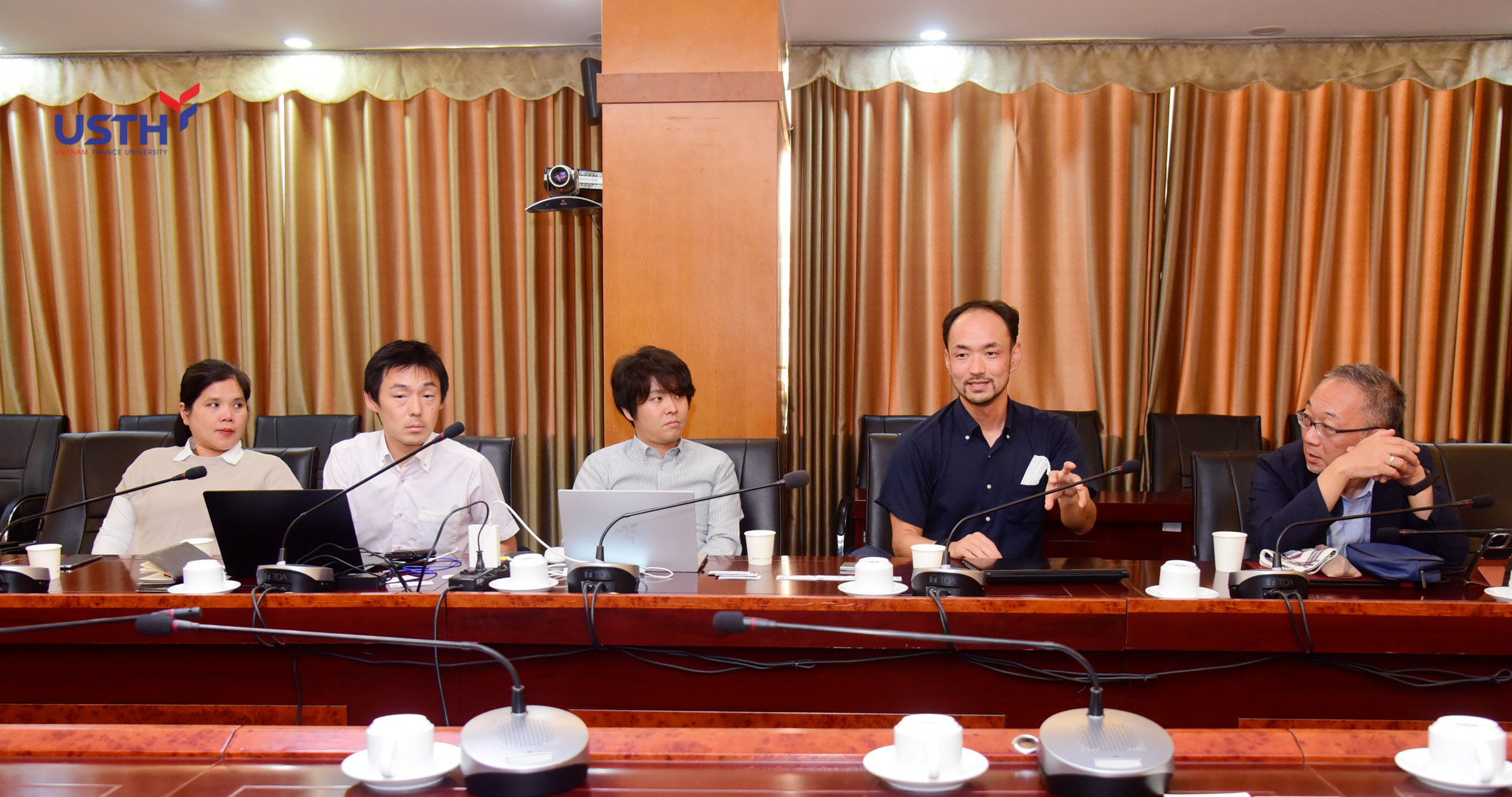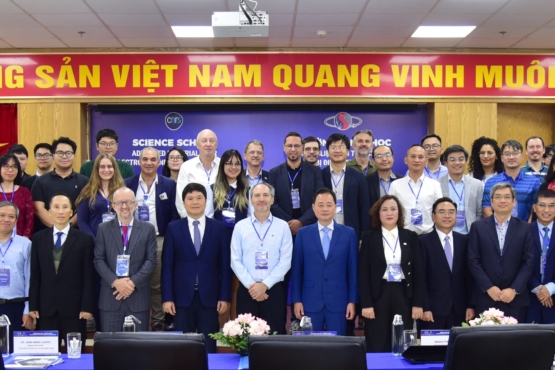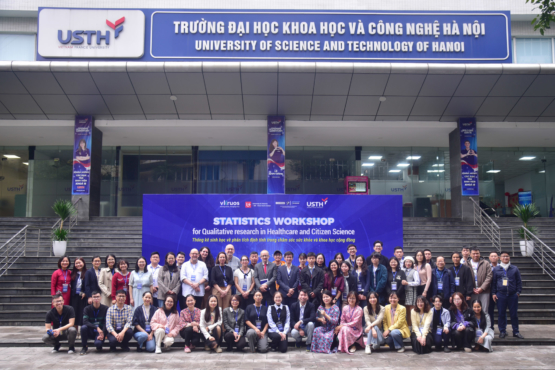On November 29th, 2022, USTH was honored to welcome a Research group from the Tokyo University of Science (TUS) to visit the university and give presentations on biomedical engineering topics at the event Café Scientifique No.12.
Participating in the event, on the side of USTH, was Prof. Jean-Marc Lavest – Principal Rector, Assoc. Prof. Nguyen Hai Dang – Vice Rector, Mr. Luc Le Calvez – Director of Direction of Research – Innovation and Technology Transfer, Assoc. Prof. Ngo Quang Minh – Director of Administration Office, Dr. Vu Thi Thu – Deputy Director of Direction of Research, Innovation and Technology Transfer; on the side of TUS, was Prof. Kohei Soga – Faculty of Advanced Engineering, Department of Materials Science and Technology, Prof. Hiroshi Takemura – Faculty of Science and Technology, Department of Mechanical Engineering, Assoc. Prof. Masakazu Umezawa – Faculty of Science and Technology, Department of Mechanical Engineering, Dr. Kyohei Okubo – Assistant Professor, Faculty of Advanced Engineering, Department of Materials Science and Technology, Dr. Doan Thi Kim Dung – Assistant Professor; and together with USTH’s lecturers and students who are passionate about biomedical engineering.

In Café Scientifique No.12, USTH honored to welcome Prof. Kohei Soga and his research group from Tokyo University of Science (TUS). The university has been one of the oldest private universities of science and technology in Japan since 1881. Rooted in a strong sense of ethics, scientists and engineers at TUS strive to solve global challenges and make the world a better place through science. With a total of 77 partner universities and agencies, and 7 alumni associations worldwide, TUS supports the research and intellectual exchange of its students and researchers. Along with the advance of science and technology, departments covering a wide range of fields were set up, and up to now TUS is the only general university for science and technology in Japan.

Five scientific presentations were made by Prof. Kohei Soga and his colleagues on the use of near infrared images and the resulting applications in the biology sector, in particular the early detection of cancers.
Prof. Kohei Soga presented the topic “Near Infrared Photonics for Biological Transparency”. Transparency of biological tissues is decided by UV and IR absorption and the variation of refractive index for bending light, except the absorption due to chromophores. Near infrared (NIR) light is located between the UV and (mid) IR wavelength range, where a valley is formed in optical loss spectra of biological tissues. The authors have utilized this NIR transparent wavelength range for bio and medical photonics to take the advantage of transparency. Important materials design for the NIR luminescent photonic materials is to control the thermal interaction between the chromophores and the surrounding. Also, the materials design of course involves the surface control for controlling the bio distribution of the materials. The presentation reviewed the materials design and applications of the near infrared fluorescent materials for biological and medical uses.
Prof. Hiroshi Takemura discussed “Contribute to the Development of Next-generation Medical Technology”. Mechanical Engineering has made remarkable progress recently and has been a considerable option in the medical field. The technology has been expected to solve the shortfall in human resources, the reduction in workload, the medical accidents prevention, and improve survival rate. However, Mechanical Engineering has a mountain of issues that remains to be solved for use in the medical field. There are huge gaps between what the strong point of mechanical engineering is and what is expected in the medical field. In his presentation, Prof. Hiroshi Takemura explained with an overview of the major trends in mechanical engineering and shared his research group’s recent studies of Biomechanics Research Lab in TUS concerning mechanical engineering including robotization and image processing in the medical field.
Assoc. Prof. Masakazu Umezawa showed the presentation “Endogenous Extracellular Vesicles (Nanoparticles) Sensitive to Temperature of Biological Deep Tissues”. This presentation was about health science with nanoparticles (NPs). Engineered, experimentally synthesized NPs are being investigated for biomedical applications to protect various molecules, such as therapeutic drugs and imaging dyes, from degradation, aggregation, and loss of function due to water, salts, and enzymes in in vivo environments. Their potentially major applications are drug delivery and controlled release using NPs. NPs that protect functional molecules such as RNA are not only artificially engineered, but are also produced endogenously in vivo. And the research group has recently been investigating the effect of muscle temperature increase caused by physical exercise on these “NPs produced in vivo”.
“Near infrared hyperspectral imaging for lipid visualization in liver” was presented by Dr. Kyohei Okubo. Lipid distribution in liver helps to diagnose nonalcoholic fatty liver disease (NAFLD) which can advance to liver cirrhosis and even hepatocellular carcinoma. Thus, a noninvasive, label-free and quantitative imaging technology is needed. Hyperspectral imaging (HSI) is a powerful imaging technique for biomedical applications including disease detection, diagnosis, and image-guided surgery. The use of near infrared (NIR; 800-2500 nm) light enables to investigate deep parts of tissue due to its lower absorption and scattering. Especially, reflectance spectra in NIR range facilitate to identify chemical composition of targets because of overtone and combination vibrations of chemical bonds. In the presentation, recent progress using NIR-HSI technologies combined with machine learning approaches will be presented.
Dr. Doan Thi Kim Dung talked about “Development of bimodal NIR-II/MRI organic probe for breast cancer detection”. Imaging guiding by combining magnetic resonance imaging (MRI) and FLI(FLI) is a prerequisite for accurately detecting and removing breast tumors during therapy. The current visible and the shorter near-infrared fluorescent probe cannot recognize breast cancer in deep tumors because tissue components tend to absorb and scatter the light, resulting in the loss of signals. Therefore, the research aims to develop an imaging probe that can recognize and detect breast cancer in deep tissues. And the project focuses on investigating technology for specifically imaging 3D breast tumors in vivo.

At the end of the event, Prof. Kohei Soga and his research group visited the laboratories of USTH. They were very impressed by the advanced equipment and the high quality of research projects and research groups at USTH. This Café Scientifique is not only an event for scientific sharing but also an opportunity for USTH to make contacts and strengthen international collaborations. As the delegations of two universities agreed, USTH will visit Tokyo University of Sciences on the sidelines of ASAIHL Conference which will be held in June 2023 in Japan.



